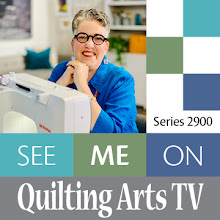
“Start With a Photo” is a workshop I will be teaching for the Charlotte Quilters Guild in April. When I started working on the sample for the workshop (see my previous post), I realized that I would have to simplify the photo even further if I was going to teach it in a 4-5 hour workshop! So in this piece, I made the barn siding all one piece, the wall all one piece (with two highlights at the top) and the grass all one piece. The window is three pieces (black, gray, and white). The rest is all done with thread painting. Here’s how it looks now that I have finished the thread painting:

Here’s how it looked after I had fused the fabric down and sketched out the stones and highlights on the boards and window, before thread painting:

These are the threads I used:

Here’s how the piece looks on the back of the interfacing used as stabilizer. You can see all the detail that has been added with the thread:

Here’s a closeup shot of the back:

I’m still planning to finish the piece I started beforehand, which has a lot more detail in the fabric pieces (it took me hours to cut the stones for the wall, for example), and think it will be an interesting exercise to see how much more detailed the finished piece will be this way. Stay tuned.
Frequently asked questions:What thread do you use for thread painting? I like “fine embroidery thread” like Mettler’s cotton merc. No. 60 and No. 50. If you use heavier-weight thread, like cotton machine quilting thread, there is more draw-up in the base fabric. Make sure you use the same weight thread in the bobbin as you are using for the top thread. I sometimes use a different color, because I like the little flecks of color that come up to the top if I have my tension slightly off. It adds very cool texture to the piece. WARNING: Quilt judges usually don't like this. They think it is a mistake! I do it anyway, because I like it. I am doing it on purpose! I think there are still a lot of quilt show judges who just don’t “get” art quilts, or who expect art quilters to follow the same rules as those for traditional quilts. Oh, well...
What stabilizer do you use? I use Pellon’s non-fusible “sew-in” interfacing. It comes on bolts about 22-1/2" wide. It is very stiff, but not too heavy, and provides a nice surface under the fabric to stabilize it for heavy thread painting. I used to use the fusible interfacing, but this works better. After I fuse down all my fabric pieces to the background, I cut the interfacing an inch bigger on all sides, and pin the fabric to it with straight quilters pins.
What fusible product do you use? I use Heat-n-Bond Lite. I keep meaning to experiment with other fusibles, but this is working for me right now, so I am sticking with it. I only use Heat-n-Bond in art quilts, because it makes the piece very stiff. I don’t use fusibles at all in my traditional quilts, or anything I’m doing by hand. In fact, I used to be so opposed to fusible products that I refused to use them at all in my first art quilt, “Teach Me to Hear Mermaids Singing,” which you can see on my website. Some of the pieces in this work (like the 1/4" fish eyeballs) were pinned down before they were secured with thread. Trying to thread paint this piece was like wrestling a porcupine. So I gave in, and started working with a fusible product.
How do you keep it from puckering up? This is technically called “draw-up,” and the best thing you can do to avoid it is to use the right interfacing as a stabilizer (see question above). Next, make sure you don’t thread paint too heavily in one area, especially right at the beginning. I try to go over the entire piece lightly, go around the outside, and then go back and do detail work on each area. For example, on this piece, I did a single line between the boards on the red fabric, went around the stones in the wall, and did simple lines in the grass first. I do not use a hoop. It slows me down, and I think it is a pain in the derriere. I know some people who love using a hoop, though.
I want to do this! Is there a book you recommend? I love
Coloring with Thread: A no-drawing approach to free-motion embroidery, by Ann Fahl (2005). She has wonderful tips and trouble-shooting lists, thread and stablizer pros and cons, plus amazing photos and samples.




















